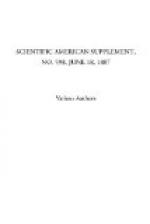Of special machines of interest, and which are too unwieldy to be shown here, I am enabled to exhibit a few photographs.
One of the most novel of these is the “Twin” machine, designed by the Singer company for the connecting together of the Jacquard cards used in lace machines. The operation was formerly performed by hand. It is now done by machine at less cost. The cards are placed upon a feeding drum, and fed beneath a pair of needles. The laces forming the connection between the cards are fed above and beneath, in line with the needles, and the whole is easily stitched together. An extension of the same device is the multiple machine, in which four needles and shuttles are used, sewing all the four seams at one operation. This method of linking the cards is considered better than similar work done by hand.
Of Wheeler & Wilson’s new factory, at Bridgeport, and of the Singer company’s great new factory near Glasgow, I am enabled to exhibit photographic views.
Before drawing my remarks to a close, I would briefly indicate the nature of the various machines shown upon the power benching. Of the Singer system, there are four. A drop-feed oscillating shuttle machine for manufacturing purposes; a wheel-feed oscillating shuttle machine, furnished with a trimmer, used chiefly in stitching leather and boot uppers; double chain-stitch machine, used for sack making, now shown for the first time; and a single thread “Lightning Sewer,” fitted with a trimmer for hosiery work. Of Wheeler & Wilson’s system, there is a drop-feed manufacturing machine with the new detached hook and latest improvements; a No. 10 machine with the usual hook, a wheel feed and trimmer, and a smaller machine of the same type with drop feed. Of Willcox & Gibbs’ system, there is the ordinary single-thread machine for manufacturing, a single-thread machine, with a trimmer, as used in the hosiery trades, and a machine specially used for straw hat making.
We have here a small Singer machine, riding upon the edge of two pieces of carpet, a carpet machine weighing ten pounds. When the handle is turned, it stitches and travels over the edges, uniting them faster and more securely than six hand sewers; and several others, representative of the family type of sewing machine, besides Wheeler & Wilson’s hemstitch machine, the working of which is of much interest.
I would now invite those of you who seek a better acquaintance with those curious and novel machines to freely examine and test the various types to be found upon the power benching and upon stands. One or two operators will come forward and show some of the capabilities of the machines upon actual work, in which the making of a straw hat will perhaps show what can be done in a few minutes by quick speed and expert fingers; but these performances must not be regarded in the light of competitive tests between the manufacturers showing them, and are intended merely to show the utility of motive power driving.




